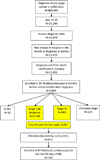High Intensity of End-of-Life Care Among Adolescent and Young Adult Cancer Patients in the New York State Medicaid Program
- PMID: 26492211
- PMCID: PMC4648674
- DOI: 10.1097/MLR.0000000000000437
High Intensity of End-of-Life Care Among Adolescent and Young Adult Cancer Patients in the New York State Medicaid Program
Abstract
Background: Little is known about the care that adolescent and young adult (AYA) cancer patients receive at the end of life (EOL).
Objective: To evaluate use of intensive measures and hospice and location of death of AYA cancer patients insured by Medicaid in New York State.
Design: Using linked patient-level data from the New York State Cancer Registry and state Medicaid program, we identified 705 Medicaid patients who were diagnosed with cancer between the ages of 15 and 29 in the years 2004-2011, who subsequently died, and who were continuously enrolled in Medicaid in the last 60 days of life. We evaluated use of intensive EOL measures (chemotherapy within 14 d of death; intensive care unit care, >1 emergency room visit, and hospitalizations in the last 30 d of life), hospice use, and location of death (inpatient hospice, long-term care facility, acute care facility, home with hospice, home without hospice).
Results: 75% of AYA Medicaid decedents used at least 1 aspect of intensive EOL care. 38% received chemotherapy in the last 2 weeks of life; 21% received intensive care unit care, 44% had >1 emergency room visit, and 64% were hospitalized in the last month of life. Only 23% used hospice. 65% of patients died in acute care settings, including the inpatient hospital or emergency room.
Conclusions: Given the high rates of intensive measures and low utilization of hospice at the EOL among AYA Medicaid enrollees, opportunities to maximize the quality of EOL care in this high-risk group should be prioritized.
References
-
- Bleyer A. The adolescent and young adult gap in cancer care and outcome. Curr Probl Pediatr Adolesc Health Care. 2005;35(5):182–217. - PubMed
-
- Wein S, Pery S, Zer A. Role of palliative care in adolescent and young adult oncology. J Clin Oncol. 2010;28(32):4819–4824. - PubMed
-
- Zebrack B, Mathews-Bradshaw B, Siegel S. Quality cancer care for adolescents and young adults: a position statement. J Clin Oncol. 2010;28(32):4862–4867. - PubMed
-
- Walter JK, Rosenberg AR, Feudtner C. Tackling taboo topics: how to have effective advanced care planning discussions with adolescents and young adults with cancer. JAMA Pediatr. 2013;167(5):489–490. - PubMed
-
- Coccia PF, et al. Adolescent and young adult oncology. Clinical practice guidelines in oncology. J Natl Compr Canc Netw. 2012;10(9):1112–1150. - PubMed
Publication types
MeSH terms
Substances
Grants and funding
LinkOut - more resources
Full Text Sources
Medical


